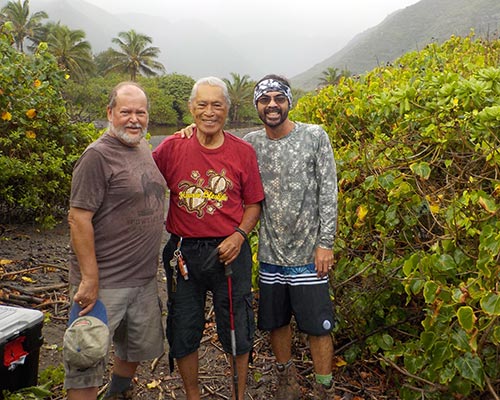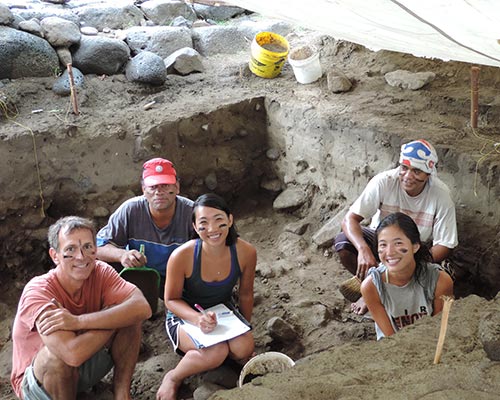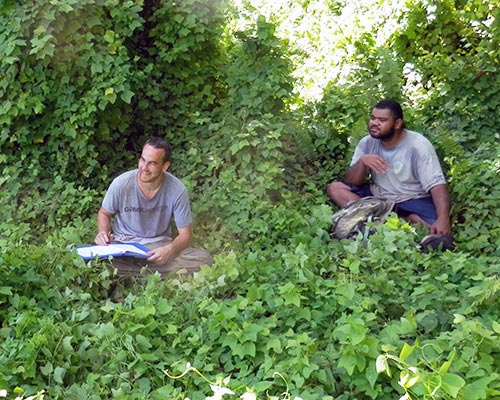When it comes to archaeology or the research of past cultures, there are so many puns about the scientific study of human activity through recovery and analysis of material remains.
“My parents strongly discouraged me from pursuing a career in archaeology – they said there is no future in it.”
“If you’re looking for a new job, don’t take up archaeology. Your career will be in ruins.”
“There’s a reason why archaeology majors are in such low demand. It’s a dying field.”
Despite the word play, the high caliber of research faculty in UH Mānoa’s Department of Anthropology is no laughing matter. Since the 1960s, College of Social Sciences’ faculty have made significant contributions to Polynesian archaeology. Locally, a longstanding research program in the Kohala region of Hawaiʻi Island has led to understanding the importance of intensive dryland field farming in the ancient Hawaiian economy. In addition, on Easter Island or Rapa Nui, UH researchers helped to unravel the mystery of the island’s oversized stone head statues.
“We’re so proud of our excellence and continuing expertise in the field,” said Professor and Chair Christopher Bae. “In fact, outside of a few schools from the Australia and New Zealand region, few programs internationally have comparable concentrations in the area of Polynesian archaeology.”
Three key faculty actively contributing to this concentration are:
Patrick Kirch
Professor Kirch’s interest in Polynesian archaeology began as a Punahou student volunteer in 1967 with the Bishop Museum, where he now serves on its board of directors. He participated in UH’s excavation of Bellows Beach in Waimānalo in 1967 with then UH archaeologist Richard Pearson, which led to the knowledge that Bellows is the oldest known occupation site in the Hawaiian Islands.
Kirch is currently co-directing a National Science Foundation funded study of ancient agricultural practices in east Molokaʻi’s Halawa Valley, where the goal is to understand how and why Hawaiian wetland (irrigated) agriculture was sustainable over many centuries. Kirch’s research team is working closely with Greg Solatorio, the son of Kirch’s longtime friend, Pilipo Solatorio. Pat and Pilipo first teamed up on archaeological projects back in 1969-1970. “And now Pilipo’s high school grandson, Raven, has also participated and is getting excited about archeology,” said Kirch. “It’s very gratifying to have this continuity, and to share mana‘o with three generations of the Solatorio clan.”
During spring break 2022, Kirch and his students will be doing field research at Kukuipahu, a heiau in Kohala, Hawaiʻi Island, with unique cut-and-dressed stone architecture. “We hope to date the construction of this unique monument, and to test the hypothesis that the temple might have been built during the reign of the great Hawaiʻi Island king, ʻUmi-a-Līloa,” said Kirch.
Barry Rolett
Professor Rolett’s specialty research interest is in the Marquesas Islands near Tahiti. “In 1981, when I was 22, I lived three months with a Marquesan family – and I have been going back regularly ever since,” he said.
Until the pandemic, Rolett was working with his Marquesan collaborators to excavate Tahuata’s Hanamiai Dune, one of the earliest archaeological sites in the archipelago. “It is telling us a lot about Polynesian origins,” he said. “It’s an indescribable feeling to watch my Marquesan friends discover a beautifully preserved fishhook or some other rare artifact, knowing that it was last touched hundreds of years ago by one of their direct ancestors. Plus, all of those artifacts are housed and exhibited in Tahuata’s own community-based museum.”
Rolett hopes to return to the region in summer 2022, if pandemic conditions allow. In the meantime, as he catches up on writing and research reports, he relives fond memories of his work at Hanamiai. “I remember once when my field team was tired and discouraged, after reaching an excavation depth of about four feet, it seemed like there was nothing more to be found. But one of the leaders, Hio, had a feeling there was something hidden below, so we continued,” recounted Rolett. “After digging another three feet, and screening countless buckets of sterile sand, we were excited to find one of the richest archaeological layers yet discovered in our research.”
Seth Quintus
Associate Professor Quintus said one of the reasons the department is considered a leader in Polynesian archaeology is because few other academic institutions have multiple specialists in the field. “Plus our connections, collaborations and relationships with Bishop Museum, Kamehameha Schools and the wider community have enhanced our ability to undertake high-quality research,” he said.
Over the past 11 years Quintus has established a specific interest in the dynamic and recurring interaction between humans and their environments in the region, with a particular emphasis on food production systems. His latest project investigates the development of economic landscapes on small islands in Samoa. “Given how long people have lived on Samoa’s small islands – roughly 2,700 years – the environments reflect place-based adaptive strategies, including the prevalence of agroforestry, terracing and unique drainage infrastructure,” said Quintus.
He is also involved in an innovative transdisciplinary project in Samoa with a trio of researchers – an Anthropology undergraduate student, and a School of Ocean and Earth Science and Technology faculty member and undergraduate student – through a UROP (Undergraduate Research Opportunities Program) funded project on basalt artifacts using Pb (lead) isotopes. “I am not the only faculty member in Anthropology to work in the Manu‘a group of American Samoa,” said Quintus. “Coincidentally, Pat Kirch excavated on one of the islands that is the focus of my research in 1987, the year I was born.”


